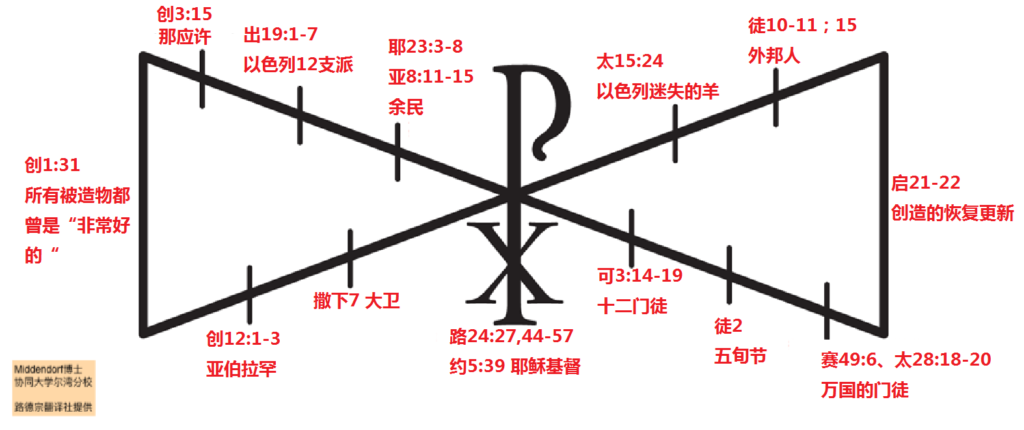Overview of Scripture
经文概述
The bow-tie diagram on the next page illustrates the overarching metanarrative of the Scriptures. It begins on the left edge with a creation that was “very good” (Gen 1:31). After the fall, God immediately promised to restore his p 1242 fallen creation through the offspring of a woman. That promise was applied to Abraham and progressively narrowed down on the left side through his descendants—Isaac, Jacob/Israel, and Judah—then on through the exodus, the royal family of King David, the exile to Babylon, the return of the remnant, and so on all the way to Jesus (from Abraham down to Christ in Mt 1:1–17; from Christ back to Adam in Lk 3:23–38).
下一页的领结图说明了圣经的总体元叙事。左边开始是 “非常好 “的创造(创1:31)。堕落之后,神立即应许要通过女人的那后裔来恢复他堕落的创造。这个应许应用在亚伯拉罕身上,并在左边逐步缩小,通过他的后裔–以撒、雅各/以色列和犹大–然后通过出埃及、大卫王的王室、被流放到巴比伦、余民的回归,一直到耶稣(从亚伯拉罕下到基督,在太1:1-17;从基督回到亚当,在路3:23-38)。
Figure 6
图示6
The Whole Story: The Bow-Tie Diagram
整个故事:蝴蝶结图


According to the NT and to Jesus himself, the whole point of the OT was narrowing down to the center point, Jesus the Christ (Lk 24:27, 44–47; Jn 5:39). It all led to the coming of the Messiah, in whom God’s promises now stand fulfilled. From Jesus the NT broadens out on the right side to include, sequentially, his twelve Jewish disciples, the lost sheep of Israel, and Jews scattered throughout the Mediterranean world. The Good News also reaches out to Gentiles as it strives to encompass all peoples and nations. God’s NT people anticipate the end of the story on the far right edge. The Messiah will come again and restore God’s creation as described in the closing chapters of Revelation, and those in Christ will reign with him forever (Rev 22:5).
根据新约和耶稣自己的说法,整个旧约的要点都缩小到那个中心点,即耶稣基督(路24:27,44-47;约5:39)。这一切都指向了弥赛亚的到来,神的应许如今在他身上得到了应验。新约圣经从耶稣开始向右扩展,依次包括他的十二个犹太门徒、以色列迷失的羊和散布在地中海世界的犹太人。好消息也传到了外邦人那里,因为它努力囊括所有的民族和国家。上帝的新约子民在最右边的边缘期待着故事的结束。弥赛亚将再来,恢复上帝的创造,正如启示录最后几章所描述的那样,那些在基督里的人将与他一起作王,直到永远(启22:5)。
Typology is one important way to apply the Christocentricity illustrated by this diagram. OT types fit on the left side of the diagram and all lead up to Christ, the antitype, at its focal point. But the NT doesn’t stop there. It goes beyond typology as illustrated by the right side. In the NT, many significant p 1243 theological themes commonly identified as typological continue through Christ and are applied to God’s people in a transformed way on the right side. They then also reach beyond the present and extend into the restored new creation. After laying out some examples, a few implications of going beyond typology will be offered.
预表学是应用此图所说明的基督中心论的一个重要方法。旧约的预表适合于图的左边,并且都通向基督,被预表的,即其焦点。但新约并没有就此停止。它超越了预表,正如图右边所展示的。在新约中,许多通常被认定为预表功用的重要神学主题通过基督继续下去,并在右边以一种更新了的方式应用于神的子民。然后,它们也超越了现在的范围,延伸到恢复的新创造。在此列举一些例子之后,也将提供一些超越预表学的几个含义。
引述索引:
Michael P. Middendorf, Romans 9–16, ed. Dean O. Wenthe and Curtis P. Giese, Concordia Commentary (Saint Louis, MO: Concordia Publishing House, 2016), 1241–1243.
*编者按:Middendorf米登多夫博士是我在协同大学尔湾分校的希腊文和保罗书信神学教授,他也是《协同圣经注释系列:罗马书》的作者。

